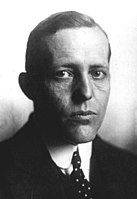Flensburg Government
| Schwerin von Krosigk Cabinet | |
|---|---|
|
30th cabinet of Germany |
|
| 1945 | |

Leading Minister L. Graf Schwerin von Krosigk
|
|
| Date formed | 2 May 1945 |
| Date dissolved | 23 May 1945 |
| People and organisations | |
| Head of government | Lutz Graf Schwerin von Krosigk |
| Head of state | Karl Dönitz |
| History | |
| Predecessor | Hitler Cabinet |
| Successor |
Allied Control Council (from 5 June 1945) |
The Flensburg Government (German: Flensburger Regierung), also known as the Flensburg Cabinet (Flensburger Kabinett), the Dönitz Government (Regierung Dönitz), or the Schwerin von Krosigk Cabinet (Kabinett Schwerin von Krosigk), was the short-lived government of Nazi Germany during a period of three weeks around the end of World War II in Europe. The government was formed following the suicide of Adolf Hitler on 30 April during the Battle of Berlin. It was headed by Grand Admiral Karl Dönitz as the Reichspräsident and Lutz Graf Schwerin von Krosigk as the Leading Minister.
The administration was referred to as the "Flensburg Government" because Dönitz's headquarters had been relocated in the port of Flensburg in northern Germany on 3 May 1945. Due to the rapid Allied advance, its nominal jurisdiction at the outset was limited to a narrow wedge of territory running from the Austrian border through Berlin to the Danish border; which, since 25 April 1945, had been cut in two by the American advance to join with Soviet forces at Torgau on the Elbe. Following the capitulation of all German armed forces on 8 May, the Flensburg government lost all direct territorial, military or civil jurisdiction, and all diplomatic relations were withdrawn. The western Allies allowed it to continue to meet and conduct what business it could until 23 May.
Once it became apparent that Hitler intended to stay and die in the besieged city of Berlin, effective overall command of German armed forces was exercised through the Oberkommando der Wehrmacht (German High Command), which had relocated to Rheinsburg. Anticipating that German-held territory would be split, separate military and civilian commands had provisionally been established on 15 April; under Field Marshal Albert Kesselring at Pullach for forces in the south and west, and under Grand Admiral Karl Dönitz at Plön for forces in the north and east; but then Hitler had stalled on transferring executive military authority to them. On 27 April Wilhelm Keitel and Alfred Jodl, of the Army High Command, met at Rheinsburg with Karl Dönitz and Heinrich Himmler to discuss the war situation now that the fall of Berlin could not be averted. Himmler took the chair as the acknowledged deputy Führer; and, since the disgrace and dismissal of Hermann Göring, Hitler's expected successor. As they were leaving Rheinsberg on 28 April, Himmler asked Dönitz to confirm that he would be willing to serve in a successor government that Himmler might form. That day however, the British and Americans published Himmler's secret proposals for a separate peace in the West (which they had rejected). On 29 April Dönitz received a telegram from Martin Bormann announcing Himmler's dismissal from all posts, and ordering his arrest for treason. Dönitz went to Himmler's headquarters in Lübeck on 30 April to confront him with the accusations, but Himmler denied them as fabricated propaganda. When a further telegram from Bormann that day confirmed both the dismissal and Dönitz's appointment as Hitler's successor, Himmler's position became untenable; and Dönitz summoned him to Plön that night to tell him so.
...
Wikipedia
